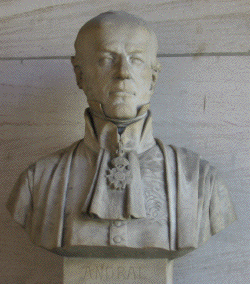 -

 -
  - Gabriel Andral
- 1797-1876
-
- Dictionnaire de médecine et de
chirurgie pratiques
-
- Publié entre 1829 et 1836.
- Dit aussi "Le Quinze volumes" ou
"Andral"
-
- Publié par les libraires et
éditeurs parisiens, Gabon,
Méquignon-Marvis et J.B.
Baillière,
- entre 1829 et 1836.
-
- Etat de la science médicale dans les
années 1830 où toutes les branches
de la médecine sont traitées en
fonction du diagnostic et du traitement des
maladies. Les articles sont signés et
sont souvent complétés de
références bibliographiques. Ce
dictionnaire présente les notions
indispensables d'anatomie, de physiologie, de
physique, de chimie et de pharmacologie pour le
médecin-praticien.
-
- Rédacteurs : les professeurs et
docteurs :
-
- Andral, Blandin, Bouillaud, Cruveilhier,
Magendie et Roche pour
l'anatomie et de la physiologie
pathologiques
- Andral, Bouillaud, Cruveilhier, Foville,
Jolly, secrétaire
général de l'Athénée
de médecine, rédacteur en chef de
la nouvelle Bibliothèque médicale,
- Magendie et Roche pour la
médecine et la
thérapeutique
- Foville, Londe et Magendie
pour les maladies
mentales
- Rayer pour les maladies de
la peau
- Dupuytren, Bégin, Blandin, Lallemand
et Sanson pour la chirurgie et
les opérations chirurgicales
- Lallemand pour les maladies
des voies urinaires
- Cullerier et Ratier pour les
maladies syphilitiques
- Dugès pour les
accouchemens
- Bouvier pour
l'orthopédie
- Andral et Londe pour l'hygiène -
Bégin, Devergie, Jolly et Sanson
pour la médecine
légale et latoxicologie
- Guibourt et Ratier pour la
pharmacologie.
- Dictionnaire de
Panckouck
-
Another question may here raised. Should the
increase in the rapidity of the blood's course,
such as is produced by fever, be ranked among
the causes which may produce congestion of the
brain? 1f, in this state of the system, several
of the tissues are obviously reddened, may it
not be supposed that the same thing will happen
to the brain? What is certain is, that we cannot
otherwise explain the pain of the head, vertigo,
perverted vision, &c., which accompany every
access of fever. In children, this morbid state
is accompanied with somnolence; there are adults
also who cannot have a fever, even of moderate
severity, without becoming extraordinarily
drowsy, or without having some delirium, which
disappears as the fever declines. Observe again
these pandiculations, the extreme
sensibility to all external impressions, the
fatigue, and dull pains in the limbs, the
general debility, which accompany fever when it
is well marked; are not all these the phenomena
which accompany certain forms or certain degrees
of cerebral congestion ? The real existence of
the latter cannot be questioned in such a case:
but far from being the cause of the febrile
disturbance, the congestion is often but an
effect of it. The production of cerebral
congestions is also favoured by the inflammation
of the different organs. The hyperemia, which
does not constitute inflammation, but which is
one of its elements, may be repeated on the
brain, and this is observed, both when this
inflammation still continues in all its force,
and when it has prematurely disappeared.
-
 -
- L'encyclopédie
méthodique Vicq d'Azyr
1782-1832
- Dictionnaire
des sciences médicales 1812-1822
Charles-Louis-Fleury Panckoucke
- Dictionnaire
de médecine Béchet ed. Adelon
1821
- Dictionnaire
de médecine et de chirurgie pratiques
ou "Andral" 1829
|






